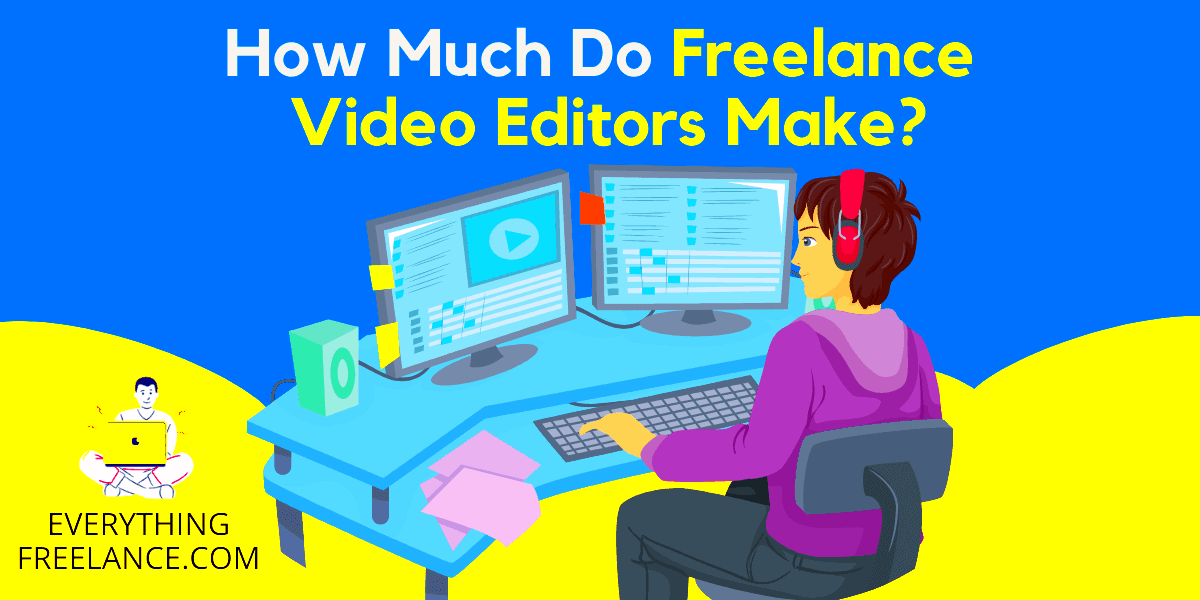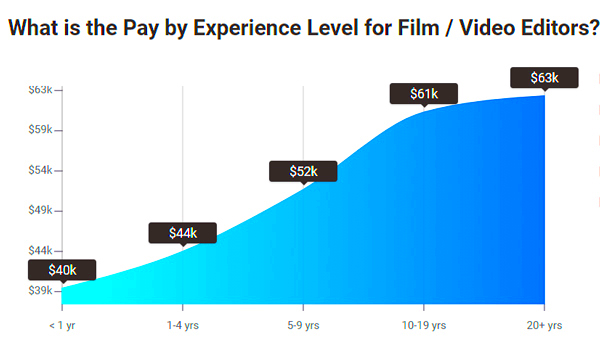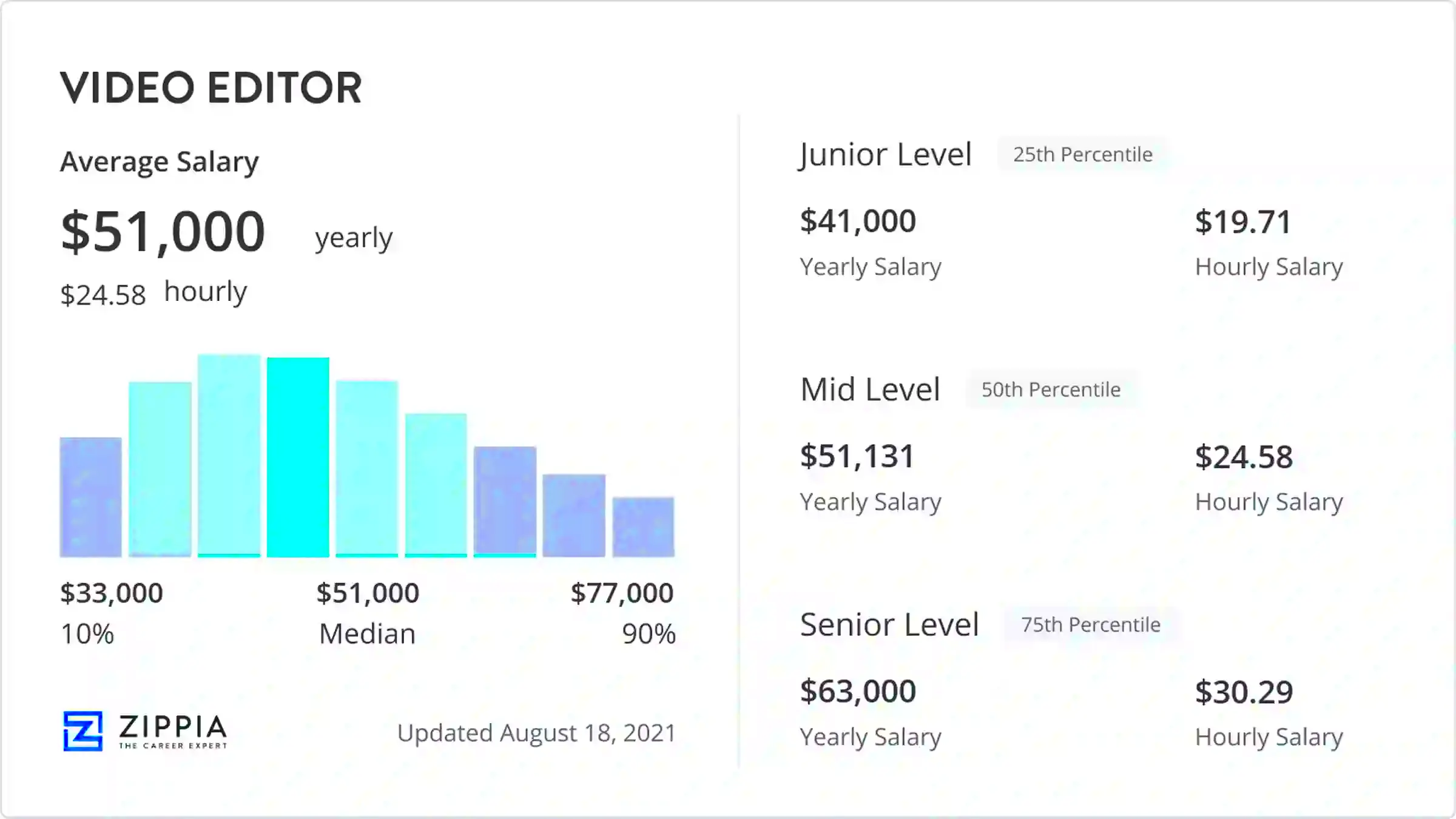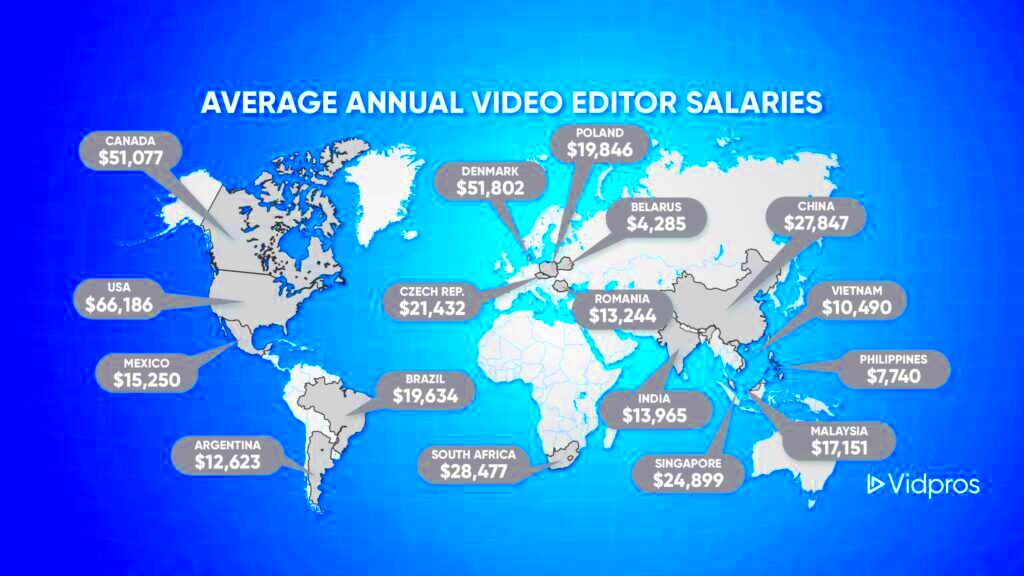
Freelance video editors earn differently due to a number of factors that influence their earnings. The following are the most important ones:
- Experience Level: More experienced editors generally command higher rates. Beginners may start lower, but as they build their skills and reputation, they can raise their fees.
- Specialization: Editors who specialize in certain niches, such as corporate videos, weddings, or social media content, may charge more due to their expertise.
- Client Type: Working with larger companies often pays more than projects for individuals or small businesses.
- Location: Editors based in cities with higher living costs might charge more to match local market rates.
- Project Complexity: More complex projects that require advanced skills or longer editing times typically result in higher earnings.
Average Rates for Freelance Video Editors

The freelance video editing, pricing may be charged hourly or on project basis. Here is how much they typically cost if you consider a person’s level of experience:
| Experience Level | Hourly Rate | Project Rate (e.g., 5-minute video) |
|---|---|---|
| Beginner (0-1 year) | $25 - $50 | $150 - $300 |
| Intermediate (1-3 years) | $50 - $100 | $300 - $600 |
| Expert (3+ years) | $100 - $200+ | $600 - $1,500+ |
These factors should also serve as a caution for the different rates charged, which may vary with time. Videographers are therefore advised to consider their abilities, how long they have been in the business and who they want as clients before establishing their rate structure.
Also Read This: How to Pay on Fiverr: A Step-by-Step Guide
Building a Strong Portfolio to Attract Clients

It is very important for freelance video editors to have a good portfolio. It’s your business card that shows what you can do to prospective clients and the kind of style you have. A good portfolio shows how good you are at doing certain things and helps you to be different from others in the industry. In this piece we will look at ways through which clients can be lured into your portfolio.
Your video editing portfolio needs these fundamental hints:
- Select Your Best Work: Choose projects that highlight your strengths. Focus on quality over quantity to make a lasting impression.
- Diverse Range: Include a variety of video styles and genres. This shows potential clients that you can adapt to different needs, whether it’s corporate videos, event highlights, or promotional content.
- Include Before and After Clips: If possible, show raw footage alongside your final edits. This helps clients appreciate your skills in transforming material into polished content.
- Client Testimonials: Positive feedback from previous clients can enhance your credibility. Include short quotes or testimonials in your portfolio to build trust.
- Keep It Updated: Regularly update your portfolio with new projects. This demonstrates that you are active and engaged in your field.
Lastly, you might think about hosting your portfolio on personal websites or Vimeo or YouTube. It will be easier for interested clients to get access to your work and you will have a chance to flaunt it pretty well.
Also Read This: Tips for Breaking Into the Industry as a Freelance Model
Setting Competitive Prices for Your Services

It can be difficult to price your video editing services. If you set your rates too low, you may regret it later because some applications may really underprice them; but if they are set too high then potential clients may run away from them. So what is the way to find the best rate? Below are various tactics you can use in putting prices that are competitive.
The following are some important factors that should be read carefully:
- Research the Market: Check what other freelance video editors are charging in your area and specialty. Platforms like Fiverr and Upwork can provide insights into prevailing rates.
- Consider Your Experience: Adjust your rates based on your skill level and experience. If you have a strong portfolio and a good track record, don’t hesitate to charge higher rates.
- Choose Your Pricing Model: Decide whether to charge by the hour or by the project. Hourly rates are useful for short-term projects, while project-based fees can work better for more extensive work.
- Value Your Time: Factor in how long it takes you to complete a project. Be realistic about the time investment and make sure your rates reflect the effort you put in.
- Be Open to Negotiation: While it’s essential to have a set rate, be willing to discuss pricing with clients. Flexibility can lead to more work and long-term relationships.
Ultimately, striking the right price means balancing your value with market demand. Some research and consideration to determine rates benefiting you and your clients is necessary.
Also Read This: Does Everyone Tip on Fiverr? Understanding the Etiquette of Tipping Freelancers
Tips for Finding High-Paying Clients
Among the most difficult feats of being a freelance video editor is obtaining clients that pay in high amounts. Nonetheless, by employing appropriate techniques, you can meet customers who value your artistry and are ready to compensate for quality. Let us elaborate on some helpful strategies for drawing them in.
Some suggestions that are useful in practice include:
- Network Within Your Industry: Attend industry events, workshops, and conferences. Networking with other professionals can lead to referrals and opportunities.
- Use Social Media: Platforms like LinkedIn, Instagram, and Facebook are excellent for showcasing your work and connecting with potential clients. Share your projects and engage with your audience.
- Join Freelance Platforms: Websites like Fiverr, Upwork, and Freelancer can help you find clients actively looking for video editing services. Optimize your profile to attract higher-paying gigs.
- Offer Value Upfront: Consider providing free samples or consultations to potential clients. This shows confidence in your skills and can lead to paid projects.
- Build Relationships: Focus on nurturing relationships with existing clients. Satisfied clients are more likely to refer you to others and come back for future projects.
If you implement these strategies, you will have a greater chance of getting high-paying clients and making your freelance career in video editing sustainable.
Also Read This: How Much to Charge for a PowerPoint Presentation on Fiverr?
Common Challenges Freelance Video Editors Face
Whilst freelance video editing is quite an interesting occupation, it does not lack its difficulties. Knowing these obstacles can enable you to manoeuvre your freelance career smoothly. Some of the common challenges faced by freelance video editors are outlined below.
Some key challenges include:
- Inconsistent Income: Unlike a traditional job, freelancing often means fluctuating income. Some months you might have a full roster of clients, while others might be slow.
- Client Expectations: Every client has a unique vision, and managing those expectations can be tricky. Miscommunication can lead to revisions and stress.
- Finding Clients: Especially when starting, attracting clients can be tough. Building a solid reputation takes time and effort.
- Time Management: Freelancers often juggle multiple projects, making it essential to manage time effectively. Poor time management can lead to burnout.
- Keeping Up with Technology: Video editing software and trends are constantly evolving. Staying updated requires ongoing learning and investment in new tools.
Difficulties could appear overwhelming but they act as chances to expand. The realization of those matters will help in enhancing your resistance and sharpening your aptitude in video editing.
Also Read This: How to Launch Your Freelance Career as a Project Manager
Frequently Asked Questions About Video Editing Income
Individuals who are in need of freelancers in video editing usually want to know how much they will earn, what are the going rates and ways in which one can thrive in this particular job. Below you will find answers to some of these nagging questions.
Some of the questions that people frequently ask include:
- What is the average income for freelance video editors? The income can vary widely based on experience and specialization, but many freelance video editors earn between $25 to $200 per hour.
- How can I increase my rates? As you gain experience and build a strong portfolio, you can gradually increase your rates. Offering specialized services can also justify higher fees.
- Is it necessary to have a degree in video editing? While a degree can be beneficial, many successful video editors are self-taught. Focus on building a portfolio and gaining practical experience.
- How do I find clients? Networking, social media, and freelance platforms are great ways to find clients. Building a strong online presence can help you attract potential clients.
- What are some common expenses for freelance video editors? Expenses can include software subscriptions, hardware upgrades, and marketing costs. It's essential to budget for these to ensure profitability.
By answering these questions, you will be able to maneuver your profession as a freelance video editor with more assurance and lucidity.
Conclusion on the Income Potential for Freelance Video Editors
The freelance video editing is a fine mix of creativity and making money. Even though there are issues involved, the advantages can be lot when one is committed and keen to acquire new knowledge. Thus, one can manage to have a stable and satisfying career by developing an impressive portfolio, charging reasonably prices, and thereafter going for customers who pay higher amounts.
It is important to note that in order to be successful in any field, one must have industry knowledge, keep on boosting one’s abilities and be a game changer. Nowadays, there are more opportunities than ever for freelancers who specialize in video editing as demand for this kind of content is continually growing on multiple platforms.
Do not stop regardless of whether you are new in the sector or you want to take your freelance career to greater heights. It can be done if proper measures are taken to ensure achievement of desired earnings as a freelancing video editor.




